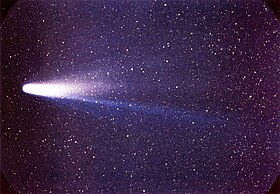What does halley's comet mean?
Definitions for halley's comet
ˈhæl iz or, often, ˈheɪ liz; ˈhæl i; ˈheɪ lihal·ley's comet
This dictionary definitions page includes all the possible meanings, example usage and translations of the word halley's comet.
Did you actually mean hallucinate?
Wikipedia
Halley's Comet
Halley's Comet, Comet Halley, or sometimes simply Halley, officially designated 1P/Halley, is a short-period comet visible from Earth every 75–79 years. Halley is the only known short-period comet that is regularly visible to the naked eye from Earth, and thus the only naked-eye comet that can appear twice in a human lifetime. Halley last appeared in the inner parts of the Solar System in 1986 and will next appear in mid-2061. Halley's periodic returns to the inner Solar System have been observed and recorded by astronomers around the world since at least 240 BC. But it was not until 1705 that the English astronomer Edmond Halley understood that these appearances were reappearances of the same comet. As a result of this discovery, the comet is named after Halley.During its 1986 visit to the inner Solar System, Halley's Comet became the first comet to be observed in detail by spacecraft, providing the first observational data on the structure of a comet nucleus and the mechanism of coma and tail formation. These observations supported a number of longstanding hypotheses about comet construction, particularly Fred Whipple's "dirty snowball" model, which correctly predicted that Halley would be composed of a mixture of volatile ices—such as water, carbon dioxide, ammonia, and dust. The missions also provided data that substantially reformed and reconfigured these ideas; for instance, it is now understood that the surface of Halley is largely composed of dusty, non-volatile materials, and that only a small portion of it is icy.
Wikidata
Halley's Comet
Halley's Comet or Comet Halley, officially designated 1P/Halley, is the best-known of the short-period comets and is visible from Earth every 75–76 years. Halley is the only short-period comet that is clearly visible to the naked eye from Earth, and thus the only naked-eye comet that might appear twice in a human lifetime. Other naked-eye comets may be brighter and more spectacular, but will appear only once in thousands of years. Halley's returns to the inner Solar System have been observed and recorded by astronomers since at least 240 BCE. Clear records of the comet's appearances were made by Chinese, Babylonian, and medieval European chroniclers, but were not recognized as reappearances of the same object at the time. The comet's periodicity was first determined in 1705 by English astronomer Edmond Halley, after whom it is now named. Halley's Comet last appeared in the inner Solar System in 1986 and will next appear in mid-2061. During its 1986 apparition, Halley became the first comet to be observed in detail by spacecraft, providing the first observational data on the structure of a comet nucleus and the mechanism of coma and tail formation. These observations supported a number of longstanding hypotheses about comet construction, particularly Fred Whipple's "dirty snowball" model, which correctly predicted that Halley would be composed of a mixture of volatile ices – such as water, carbon dioxide and ammonia – and dust. The missions also provided data which substantially reformed and reconfigured these ideas; for instance it is now understood that Halley's surface is largely composed of dusty, non-volatile materials, and that only a small portion of it is icy.
Numerology
Chaldean Numerology
The numerical value of halley's comet in Chaldean Numerology is: 8
Pythagorean Numerology
The numerical value of halley's comet in Pythagorean Numerology is: 3
Translation
Find a translation for the halley's comet definition in other languages:
Select another language:
- - Select -
- 简体中文 (Chinese - Simplified)
- 繁體中文 (Chinese - Traditional)
- Español (Spanish)
- Esperanto (Esperanto)
- 日本語 (Japanese)
- Português (Portuguese)
- Deutsch (German)
- العربية (Arabic)
- Français (French)
- Русский (Russian)
- ಕನ್ನಡ (Kannada)
- 한국어 (Korean)
- עברית (Hebrew)
- Gaeilge (Irish)
- Українська (Ukrainian)
- اردو (Urdu)
- Magyar (Hungarian)
- मानक हिन्दी (Hindi)
- Indonesia (Indonesian)
- Italiano (Italian)
- தமிழ் (Tamil)
- Türkçe (Turkish)
- తెలుగు (Telugu)
- ภาษาไทย (Thai)
- Tiếng Việt (Vietnamese)
- Čeština (Czech)
- Polski (Polish)
- Bahasa Indonesia (Indonesian)
- Românește (Romanian)
- Nederlands (Dutch)
- Ελληνικά (Greek)
- Latinum (Latin)
- Svenska (Swedish)
- Dansk (Danish)
- Suomi (Finnish)
- فارسی (Persian)
- ייִדיש (Yiddish)
- հայերեն (Armenian)
- Norsk (Norwegian)
- English (English)
Word of the Day
Would you like us to send you a FREE new word definition delivered to your inbox daily?
Citation
Use the citation below to add this definition to your bibliography:
Style:MLAChicagoAPA
"halley's comet." Definitions.net. STANDS4 LLC, 2024. Web. 23 Apr. 2024. <https://www.definitions.net/definition/halley%27s+comet>.



Discuss these halley's comet definitions with the community:
Report Comment
We're doing our best to make sure our content is useful, accurate and safe.
If by any chance you spot an inappropriate comment while navigating through our website please use this form to let us know, and we'll take care of it shortly.
Attachment
You need to be logged in to favorite.
Log In